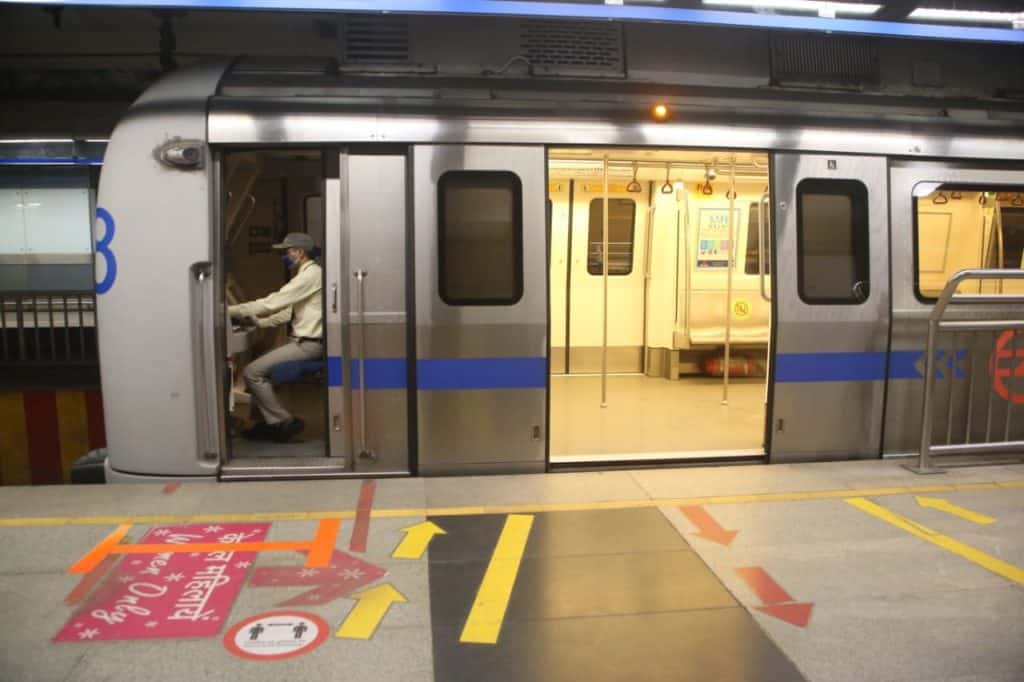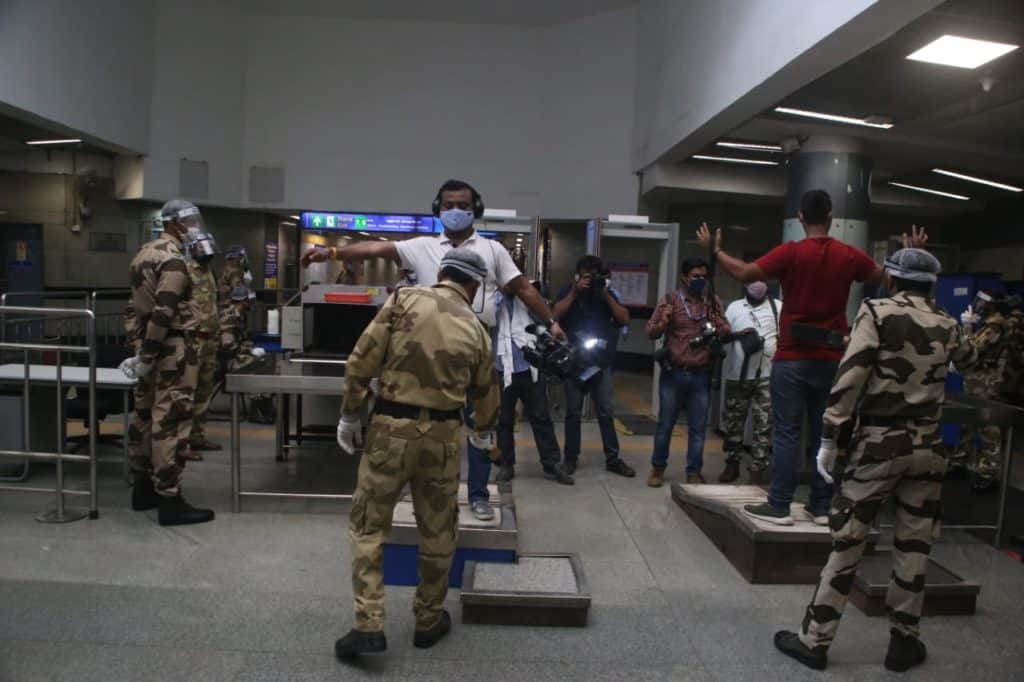There is joy, and there is concern tinged with fear and uncertainty. “Get ready for the next wave of infection transmission… Reason… Metro opened for all. When there were 200 per day cases, everything was closed. Now when it’s 77,000 cases per day, government plans to open Metro. Can somebody explain the rationale??” asked one tweet when DMRC on August 29 went public with #MetroBackOnTrack
Finally, after a gap of more than five months and a week, the metro stations and coaches of the National Capital Region will see people who are willing to go through the restrictive, controlled and strictly enforced entry, travel and exit conditions.
The Delhi Metro on September 3rd put out a new travel protocol for passengers and preventive measures to ensure COVID-free metro premises, and advised passengers to factor in about 15 minutes more for their travel.
The gates of all the metro stations are presently tightly shut but one can see staff sweeping the steps, wiping clean the railings, grills etc. But when the gates open for the public on September 7th, regular commuters like Varsha Kumar will see a lot of new features, all intended to make the different steps as contactless as possible.
They will also see the post-lockdown avatar of the metro, which a CISF jawan on duty at the Kaushambi Metro Station assured will be “far easier” than boarding a train or a flight. “Logon ko iski bahut zaroorat hai” (People need this a lot) he said
Varsha Kumar, a NOIDA resident and working in a nationalised bank branches just outside the Barakhamba Road metro station in central Delhi had got used to travelling comfortably in the Delhi Metro, and would proudly say it took her a little over 45 minutes to get to office.
But ever since the first Unlock even after the pandemic struck, when some offices including hers opened, it was quite an effort she had to put in to get to work. Asking her husband to drop her, or take an auto because she wanted to avoid a Delhi Transport Corporation bus. Always hoping the metro would restart soon.

THE NETWORK
With 389 kms of metro tracks and 285 stations in the National Capital Region, the metro is both the lifeline and the pride of Delhi. With its frequency –generally a train every two or three minutes– the metro got people from wherever to wherever at a speed a car or a bus just cannot match. For the public, it was also a journey in air-conditioned comfort. While in terms of network spread, speed, and state-of-the-art technology, the Delhi metro will compare favourably with the best in the world.
There was no particular peak hour on Delhi Metro, though officially, off peak hours were before 8 am, from 12 noon to 5 pm, and 9 pm onwards. On July 29, 2019, DMRC spokesman had proudly announced the highest ridership till then– a whopping 59,05,431 passengers!
It was a trend that continued through the year and into 2020, when the average ridership in February was 57.13 lakh passengers a day. In March. before the COVID-19 lockdown, the daily average was 46.53 lakh passengers.
Almost every “line” that makes for the web shaped Delhi Metro, is as crowded as any other, given the complete connectivity through 27 interchange stations. But the most used line is probably the Yellow Line going through Chandni Chowk, Rajiv Chowk, New Delhi etc, which has the longest underground section. The average on this line is about 15 lakh passengers daily.
Varsha’s journey now will be very different from the past. At a press conference on September 2, Hardeep Puri, Union Minister for Housing and Urban Affairs, explained how the metro ride would be different.
- For one, fewer gates of the metro stations will be open for entry and exit. Typically, most stations have at least four gates, opening into different localities around. Post September 7, one or at most two entrances, and two exits will be opened to regulate passengers. Entrances will no longer double up for exits as well. Minimum luggage and no metallic items will be allowed into the metro system.
- Secondly, the Aarogya Setu app will be a must. Passengers will mandatorily have to wear their masks, will be provided hand sanitisers, and will be subjected to thermal scanning. Anyone not clearing the scan will not be allowed to enter the station and directed to the nearest medical centre, and the local health authorities and administration will be informed.
- Thirdly, tokens are totally out. Smart cards, loaded with new contactless App-based features, will be what the Automatic Fare Gates have been modified to recognise. The DMRC is introducing a new type of Smart Card which comes with an Auto Top Up feature, through the “AutoPe” app, in which DMRCL has developed and included its smart card payment menu. AutoPe, launched in June, is a digital payment app like any other, which is linked to your bank account and can be downloaded from Google play store. According to DMRC, 70% of passengers use the smart card. The AutoPe feature will become operational on the day Metro services resume.
- The DMRC in an August 19th press release had said existing smart card holders can also get this feature activated. The smart card, which requires a minimum Rs 200 expenditure, with Rs 100 as deposit, makes for easy entry through the fare gates, besides giving commuters a 10% discount on fares. New smart cards can be bought at stations by digital payments only. No cash will be accepted.
- Fourthly, the in-coach experience will be different. Where 7 seats were often shared by 8 to 10 people, now alternate seats will have to be left vacant. Standing passengers were almost glued to each other, particularly during peak hours. Now a one metre gap will have to be left between two standing passengers.While circles have been drawn inside for standing passengers, it is not mentioned whether there will be people deployed inside to monitor this. Much will perhaps depend on passengers voluntarily following the guidelines.
- Fifthly, the stop at any station will be for half a minute to a minute more than usual, in order enable smooth boarding and deboarding, ensuring social distancing. This will necessarily mean the time a passenger takes to get from point A to point B, will be more than it was pre-March 22, 2020. The metro frequency will be 5 to 7 minutes as against 2.5 minutes before the lockdown.
- Sixthly trains will not stop at stations falling in containment zones.
- Seventh, passengers should not be surprised if the train does not stop at the station they intended getting off. The DMRC has decided to skip stations where the platforms are overcrowded, and social distancing has not been maintained.
- Eighth, “passenger behaviour” will be monitored continuously. Puri warned that those not behaving according to the needs of the time (social distancing, mask) will be named and shamed right in the train, using the public announcement systems.
- Ninth, the trains will stop for a “longer duration” (time was not specified) at the terminal stations, and all the doors will be kept open, in order to allow fresh air into the coaches.
- Tenth, the air conditioning of the trains will also be reset to ensure 50 to 60 % more fresh air, and the air filters will be cleaned using a 5 % bleach solution, and more often than earlier.
“I downloaded and installed AutoPe. It asks for name as in PAN, email ID, mobile number and you have to agree to them checking my credit position with RBI. I agreed and went to the next page, but found it too invasive as far as my banking/ finances are co concerned. I went back , uninstalled the App. I have been using PayTm the last two plus years to recharge Delhi metro smart card. And I have not had to do any e-KYC with PayTm. This AutoPe is one more like PayTm, but with a mandatory link to PAN”.
— A Metro Commuter

Sources in Delhi Metro say that the air-conditioning may “be somewhat less” once the services resume. Managing the air circulation inside the coaches, such that fresher air –read hot air– from outside is thrown in to disperse suspended viral particles, could see cabin temperatures go up beyond the 24 to 30 degrees Celsius that commuters are used to.
“When it is very crowded, it has gone up to more than 33 degrees inside, and passengers are used to that,” explained a metro driver in Vaishali, the last station on the east end of the Blue Line. He cheerfully added that in any case now the trains are going to be far less crowded.
In fact, four trains have been running in all the lines all these days mornings and evenings, to transport essential staff. The DMRC has rotated the coaches such that the entire fleet has remained in good running condition.
The DMRC and the Ministry for Housing and Urban Affairs will monitor and review the metro service on a weekly basis.